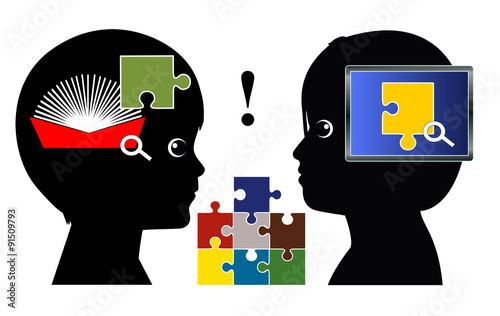
I. Source-based Projects
In these projects, the teacher steps out the traditional role of being an
context expert and information provider, and instead lets the students find
their own facts and information. Only when necessary for the active learning
process does the teacher the step in to supply data or information. The general
flow of events in resource-based projects are:

1. The teacher determines the topic for
the examination of the class.
2. The teacher represents the problem to
the class.
3. The students find information on the
problem/questions.
4. Students organized their information
in response to the problem/questions.


|
Traditional learning model
|
Resource-based learning model
|
|
Teacher
is expert and information provider
|
Teacher
is guide and facilitator
|
|
Focus on
facts
Information
is packaged
In neat
parcels
|
Focus on
learning inquiry/quest/discovery
|
|
The
product is the be all and end all of all learning
|
Emphasis
on process
|
|
Assessment
is quantative
|
Assessment
is quantitative and qualitative
|

A Webquest-
is am inquiry-oriented activity in which most or all of their information used
by he learners are drawn from the web.

II. Simple
Creations
- Students can also be assigned to create their software materials to supplement the need for the relevant and effective materials.
- In developing software, creativity as an outcome should not be equated with ingenuity of high intelligence. Creating is more constant with planning, making, assembling, designing, or building. Creativity is said to be combine in three kind of skill/abilities:
Analyzing- distinguishing
similarities and differences/ seeing the project as a problem to be solved
Synthesizing- Making
spontaneous connections among ideas, thus generating interesting or new ideas.
Promoting- selling of new
ideas to allow the public to tell ideas themselves

The
Five Key Tasks
1. Define the task- clarify the goal of
the completed project to the students.
2. Brainstorm- The students themselves
will be allowed to generate their own ideas on the project.
3. Judge the idea- The students
themselves make an appraisal for or against any idea.
4. Act- The students do their own work
with the teacher a facilitator.
5. Adopt flexibility- the students should
allow to shift gears and not follow an action path rigidly.

III. Guide
Hypermedia Projects
The production of self-made multimedia projects can be approached in two
different ways:
1. As an instructive tool, such as in
the production by students of power-point presentation of a selected topic
2. As a communication tool, such as when
students do a multimedia presentation (with text, graphs, photos, audio
narration, interviews, video clips, etc. to simulated a television news show.

IV. Web-based Projects
Students can be made to create and post webpages on a given topic. But
creating webpages, even single page webpage, may be too sophisticated and time
consuming for the average students.
Walang komento:
Mag-post ng isang Komento